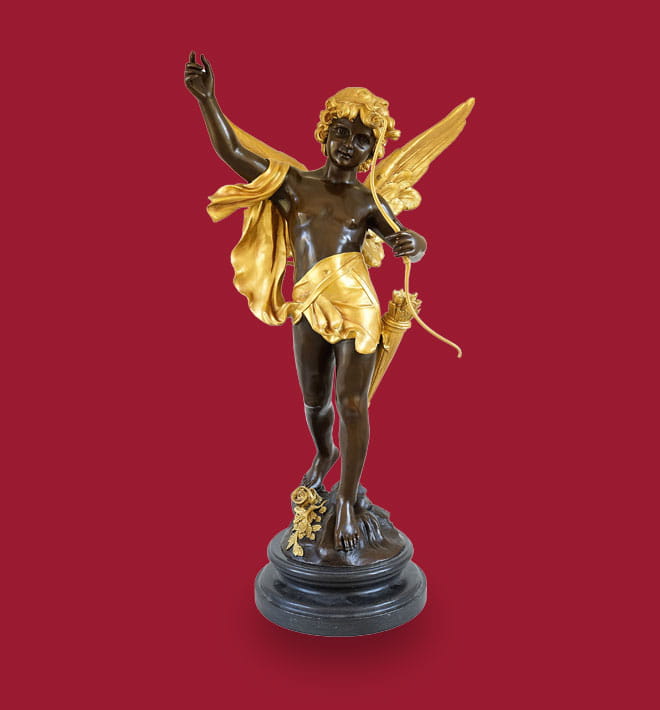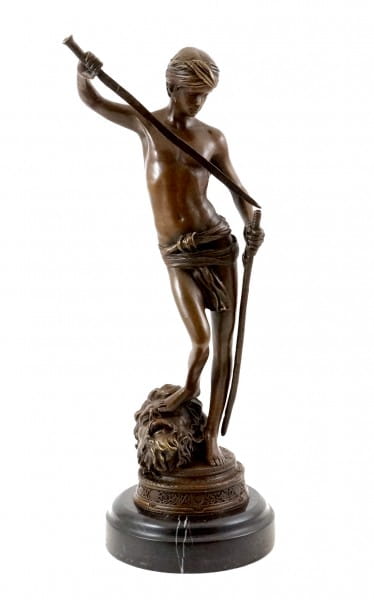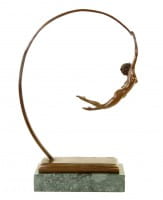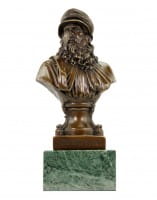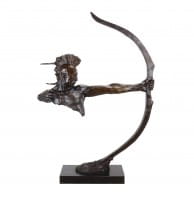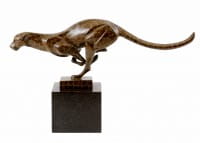Prices incl. VAT, free shipping worldwide
Ready to ship today,
Delivery time appr. 3-6 workdays










Product description
"Bronze Statue - David after the fight - sign. Antonin Mercié"
| Height | 33 cm |
| Width | 11 cm |
| Length | 10 cm |
| Weight | 2,3 kg |
David After the Battle: A Bronze Masterpiece – Signed by A. Mercié
In David After the Battle, Antonin Mercié presents Goliath's conqueror not with a triumphant roar, but in the quiet moment after victory. The young hero stands with a dripping sword, his head bowed in thought. Every muscle – from the subtle tension of his bare arms to the gentle curve of his torso – testifies to both the physical exertion of battle and the emotional burden of fulfilling his destiny. This bronze statue, signed "A. Mercié" on the base, transforms stone and metal into living poetry.
From the Streets of Toulouse to the Parisian Studios
Antonin Mercié was born in 1845 in Toulouse, France, the son of a respected local sculptor who introduced him to clay and chiseling at an early age. His exceptional talent led him to the École des Beaux-Arts in Paris, where he studied under François Jouffroy and Jean-Louis-Ernest Meissonier. By the 1870s, Mercié gained recognition not only for his classical mastery, but also for his novel sense of narrative and emotion in sculpture.
David's Aftermath 1876
In 1876, in Mercié's studio near Montparnasse, David was created as a life-size clay figure after the battle. Mercié studied historical texts and Renaissance drawings to capture the precise moment when triumph turns inward. He spent months refining and perfecting the pose. The clay was then sent to a renowned foundry on the Seine, where artisans cast every nuance in molten bronze using the lost-wax technique. A warm patina, applied by Mercié himself, adds depth to every wrinkle and depression.
Anatomy Interwoven with Reflection
Unlike statues that freeze heroes in grim bravado, this work unites form and emotion. David's shoulders bear the pain of battle; his gaze, fixed on the tip of his sword, suggests a contemplation of the cost of conflict. Every anatomical detail—from his ribs to his strained calves—is rendered with Mercié's supreme precision, yet entirely in the service of a deeper, more human narrative.
The Artistic Legacy of Antonin Mercié
Over the course of his fifty-year career, Mercié combined academic tradition with modern sensibility. His equestrian statue of Joan of Arc and his poignant portrait busts testify to a sculptor who combined precise technique with profound empathy. He received the Grand Prix at the 1878 Universal Exhibition and became a professor at the École des Beaux-Arts, where he passed on his sophisticated narrative skills to subsequent generations.
A statement for connoisseurs
Placed on a custom-made marble base, this bronze statue adds dignity and intimacy to any elegant setting—whether in the quiet of a library or the spotlight of a gallery. The interplay of polished highlights and deeply patinated shadows creates a vibrant surface that changes with the viewer's movements, revealing new details: the twitching of muscles beneath the skin, the tenseness of a bent finger, the gentle curl of the cloak around David's hips.
A lasting testament in bronze
David After the Battle, signed "A. Mercié" and cast in the same year, is a testament to the power of bronze to convey not only heroism but also contemplation, not only victory but also its consequences. In the hands of Antonin Mercié, the story of the young shepherd takes on a new resonance—a reminder that the true mark of a hero is not victory alone, but the dignity with which he bears the memory of it.
Our advantages
free shipping
Worldwide free shipping
14 days money back
You can cancel your order
within 14 days
secure payment services
Paypal, Master Card, Visa, American Express and more

